Hosta - care in the fall and preparation for winter: pruning and shelter (mulching)
An important component of the autumn care of the host, so that in the next season it will again delight you with its spectacular appearance, is its proper preparation for winter, namely pruning and shelter (mulching).
Let's understand the nuances.
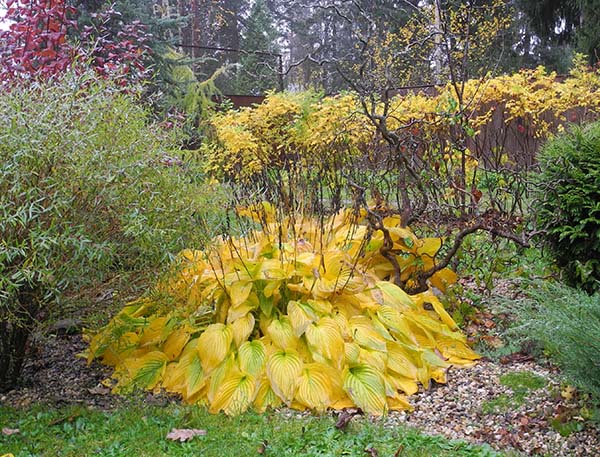
Content
Features of care in the fall and preparation of hosts for winter: main activities
Many gardeners say that the hosta does not need special preparation and specific shelter from strong drops in temperature. But this judgment is wrong. This formulation is only suitable for plants that are grown in southern regions.
The plant tends to bloom in July-October, depending on the species and variety, thereforeInitial preparation for winter involves removing buds that have faded. Such an element of caring for hosts in summer and autumn is necessary so that the plant does not expend its energy on the formation of seeds and their ripening.
By the way! If your hosts do not bloom very beautifully (of the usual variety), then you can not let them bloom at all, but cut off the flowering arrows immediately after they appear.
The host loves moisture and abundant watering. The plant is able to independently signal the need to water it, namely: it lowers its leaves to the ground. Moreover, you should not allow the leaves to dry out.
The hosta also needs watering during the autumn months. The soil under it should be abundantly shed so that the entire root system is saturated with life-giving moisture before wintering. When the temperature starts to decrease, watering will need to be gradually reduced, and then completely stopped.
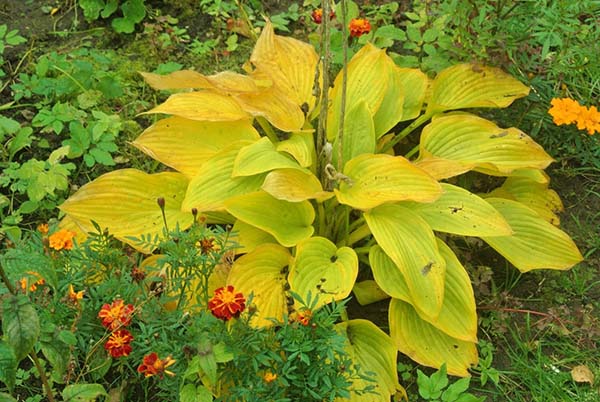
The last nitrogen feeding is carried out in the first half of summer for a more lush growth of greenery. In the second half of summer, and even more so in autumn, no nitrogen fertilizers are required, because they will provoke the growth of green mass and plant rhizomes, because of which it can winter badly, and its resistance to diseases will definitely decrease.
For better preparation of the plant for winter in the fall, it needs phosphorus and potassiumso you can feed the hosta with, for example, bone meal and wood ash (for lovers of organic farming) or mineral fertilizers - potassium sulfate (20-30 grams) and superphosphate (30-40 grams per 1 square meter of the garden) or with a special ready-made "autumn" fertilizer (according to the instructions).
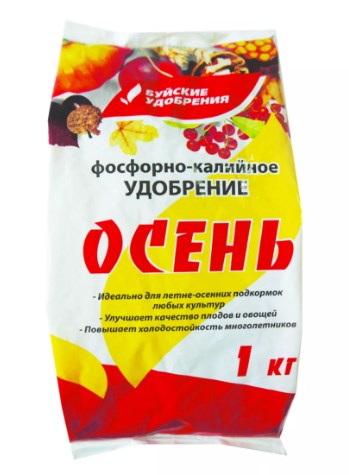
Advice! It is better to dissolve mineral fertilizers in water (in 10 liters), and organic fertilizers - just pour around the plant, and then water.
With the onset of cold weather hosts should be covered, or rather mulched. For this, mown grass and peat are well suited (they must be mixed so that the grass does not cake).
By the way! Sawdust absorbs a lot of moisture, and in winter it can be harmful.
And in the fall you can share and transplant hosts.
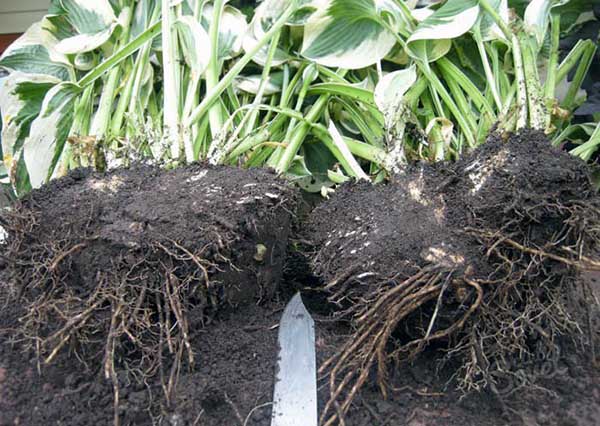
Pruning hosts in the fall
The question "Should the host be cut for the winter in the fall?" - is the cause of disputes for many gardeners.
Some argue that cutting the foliage is highly discouraged. After all, it contains all the nutrients that must independently move from greenery to the root of the plant. And already upon completion of this process, the tops naturally die off by themselves.
Others (inexperienced growers) argue that it is necessary to prune the hosta leaves for the winter.
So should the host be pruned in the fall for the winter?
According to most experienced gardeners, this is a rather pointless procedure that can be performed only for aesthetic (decorative) purposes, because the plant overwinters well with leaves.
But if you still decide to cut the host for the winter, then when should it be done?
The main signal that the plant can be cut is when the leaves turn completely yellow. This means that all the nutrients have already been safely transferred to the root system.
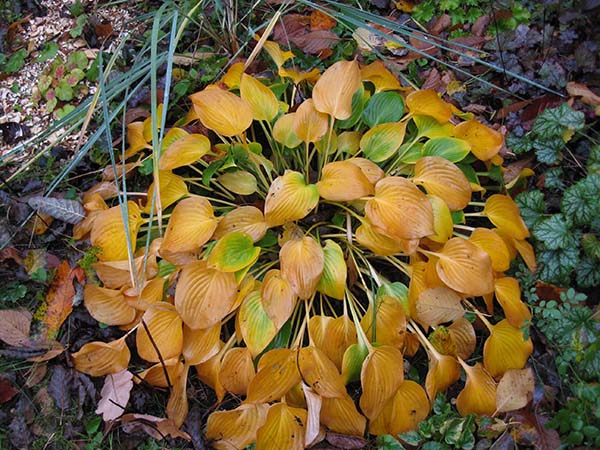
How to prune hosts in the fall?
Take your pruning shears and cut off all the leaves, leaving about 10 centimeters (1 in) stumps.
Important! In general, pruning is best done in the spring, or rather, you can just take a rake and remove the foliage that has died out during the winter.
Video: why you don't need to crop hosts in the fall
Shelter hosts for the winter
Many novice amateur gardeners are thinking about whether to cover the host for the winter. It should be said right away that in cold regions the plant really needs to be sheltered. However, the essence of this shelter comes down exclusively to mulching the area around the bush.
In general, hosts are quite frost-resistant plants, and besides, you do not need to preserve the aerial part, every year it grows again.
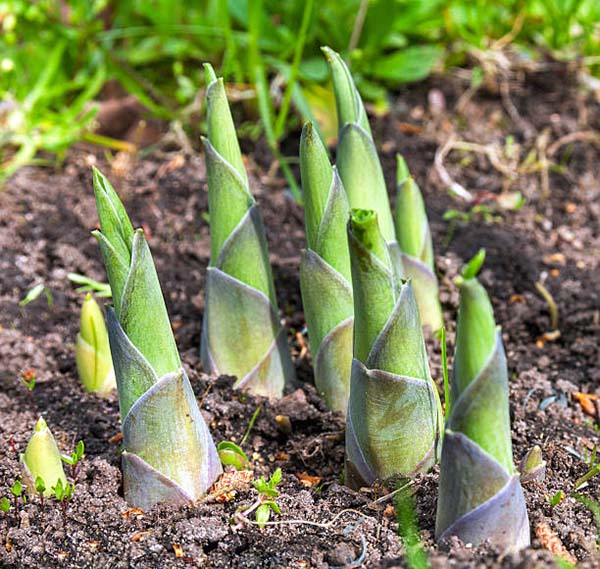
So how do you properly cover your host for the winter?
Note! Obviously, it is necessary to have time to mulch before the onset of frost.
Mulching (sheltering) hosts in the fall should be performed in the following sequence:
- 1. Prepare the mulch itself. For example, it can consist of cut grass and peat (more). Also you can use bark or compost.
By the way! In principle, you can take the most common garden land... But using grass, peat or compost will serve an excellent organic fertilizer in the spring.
-
2. Next, mulch the plant, covering it with a layer of 5-10 centimeters from all sides. Just don't put mulch on top of the leaves! Another thing is, if you cut off the leaves, then you can fill it with a mound. In general, for the winter, the host should leave with leaves, which will finally fall after dying off and become an additional shelter.
Important! Such a shelter is quite enough to protect the plant roots from severe frosts.
Generally, you do not need to use special nonwoven covering materials such as agrofiber or spunbond.
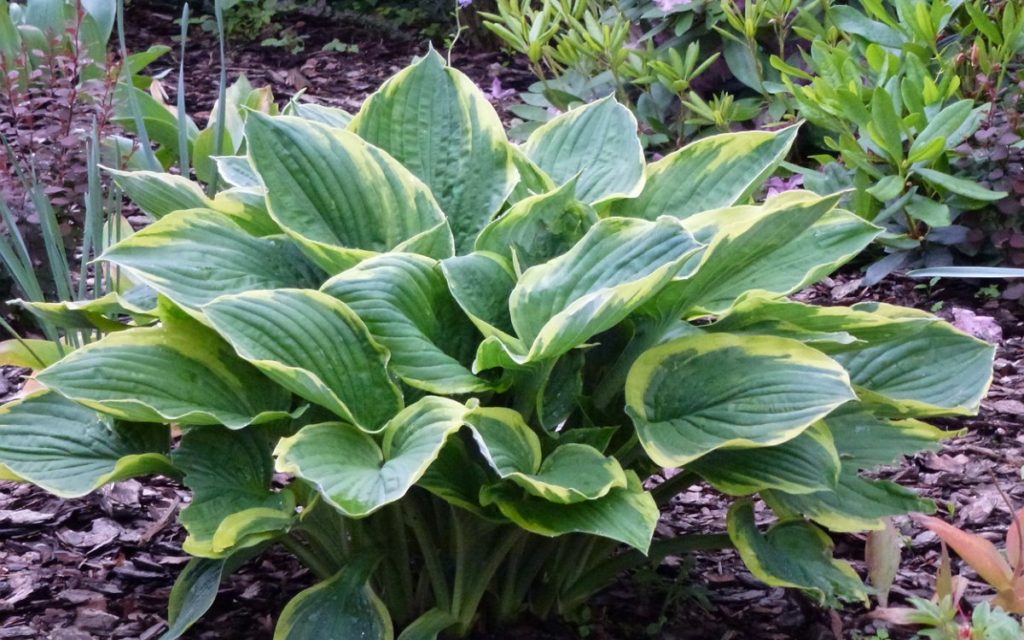
Advice! In early spring, do not forget to rake off the mulch to allow the soil to warm up better and the plant grows faster.
Features of preparing hosts for winter in different regions
Each region has its own nuances of growing plants, in particular hosts. But as for autumn care and preparation for winter, there are differences only in the peculiarities of the shelter for the winter.
Important! If you have snowless winters, then you can play it safe and additionally cover with non-woven material or spruce branches.
In the south of Russia
Hosts that are grown in the southern regions (for example, in the Krasnodar Territory) practically do not need shelter. It's another matter if you live in the Volgograd region, where there are quite strong and prolonged frosts.
The approximate dates for mulching (sheltering) the host in the southern regions are the last days of October - the first half of November.
In the middle lane (Moscow region)
In the conditions of the Central strip (Moscow region), it is imperative to cover the host for the winter. In this case, it will be quite enough to mulch the root area with a thick layer of peat mixed with cut grass, or use bark or compost.
The approximate timing of shelter (mulching) hosts in central Russia (Moscow region) - the end of September - the first half of October.
In the Urals and Siberia
The conditions of the Urals and Siberia are characterized by severe frosts and sub-zero temperatures. Therefore, a shelter similar to the middle lane is also needed here. At the same time, for additional insulation, you can throw snow masses over the plant or immediately cover it with spruce branches.
The approximate timing of shelter (mulching) hosts in the Urals and Siberia is September.
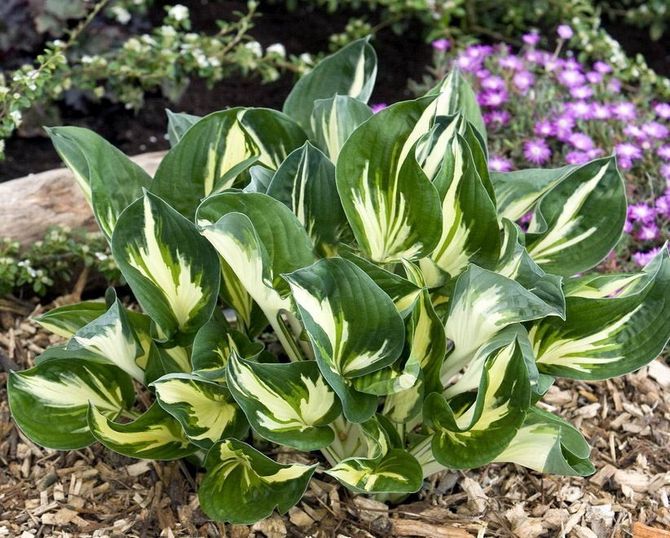
Typical mistakes in caring for a host in the fall when preparing for winter
Many gardeners, without thinking about the consequences, are able to commit rash actions that can harm the plant. But the wrong autumn care for the hosta in the fall can cause severe damage to the plant.
There are several mistakes that should not be made when caring for a plant in autumn and preparing it for winter:
- Top dressing with nitrogen fertilizers with the onset of autumn - nitrogen fertilization entails the activation of leaf growth, so the plant will try to release young leaves, and not prepare to go on winter rest.
- Lack of shelter (mulching) or, on the contrary, the use of special materials for shelter, especially waterproof ones (for example, films)... The thing is that hosts winter well just under a thick layer of mulch or without it at all.
Thus, taking care of the hosta in the autumn does not present any particular difficulties. To do this, you just need to know the rules for pruning it - cut off only flower stalks at the end of summer, and do not waste your precious time on autumn pruning of foliage. Much better to do her shelter, or rather mulching.
Video: preparing hosts for winter


One of the best articles about caring for not only a host, but also perennials in general. A lot of useful and necessary information, successful, unobtrusive, as is usually the case, the use of video materials.